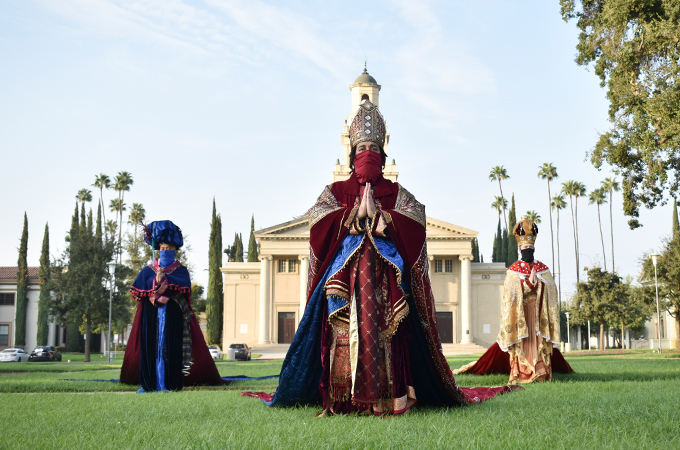As the coronavirus spread across the country in March, leaving a string of canceled and rescheduled events in its wake, dozens of University of Redlands community members began to think about the annual Feast of Lights.
“I had a hunch that this year’s feast would be different, but there was never a question as to if it would take place,” says School of Music Professor Nicholle Andrews, who has been directing the event for 12 years. She is the third director in its 73-year history.
Breathing new life into history
A U of R tradition, the Feast of Lights is an annual celebration of the birth of Jesus through spoken word, tableaux, song, and instrumental composition. This year, the event will be presented in a virtual format, featuring a special mix of performances by students, faculty, and alumni, culminating in a grand performance of “Silent Night,” sung by a group of the event’s past participants.
Ensuring that community members experience a Feast of Lights, even under unprecedented circumstances, was paramount to many participants, including Peter Tupou, a U of R employee who has been involved in the celebration since 2001.
“Continuing the Feast this year is especially meaningful because of what it means to many feast goers,” says Tupou, who has appeared in the event as one of the three kings for the past eight years. “A single candle shines brightly in the darkness of the Memorial Chapel and that light gives life to other lights, until the emptiness is filled with warmth and music—that symbolizes hope in this difficult time and reminds us that this, too, shall pass.”
Working with a small group of technicians—including a stage director, Artist Professor Marco Schindelmann; a videographer, Stage and Equipment Coordinator Michael Raco-Rands; and an audio engineer Director of Music Admissions and Technology Brad Andrews—Nicholle explored previous recordings of the Feast and chose to include pieces from the 1954, 1956, and 2007 iterations, as well as newly recorded organ performances.
One of the challenges has been digitizing decades-old material—film reels, audio recordings, and photography—in order to include pieces of them in this year’s virtual celebration. There’s always a risk the film will break in the process, but she was committed to bringing the work of past musicians, some of whom have passed away, back to today’s audience.
“Our team worked through the summer to figure out how to make the Feast happen,” she says. “Hours of meetings, exploring a variety of online platforms, selecting appropriate repertoire, and ensuring that the virtual Feast would be accessible to our community.”
Learning new things
In addition to technical logistics, Nicholle had to work through assigning the event’s repertoire and assisting students in its execution. Once students had memorized and recorded their individual parts, 480 digital files were submitted to her, and she reviewed each one for tempo, pitch, and other factors. As the pieces were strung together through a labor-intensive editing process, Nicholle worked with Brad to make small adjustments, bringing voices and instruments into perfect virtual harmony.
“Working together with Nicholle to master the pieces and bring life to our online ensembles has been incredibly rewarding,” says Brad. “While it’s not the way we’re used to making music, we’re excited to be making music and continuing this wonderful tradition. The students have been forced to do more critical listening of their individual performances, and they’ve risen to the challenge of learning new technical skills alongside enhancing their musicianship.”
As a result, this year’s Feast of Lights has offered students a crash course in sound engineering that they wouldn’t have otherwise received. Holding rehearsals on video conferencing platforms is nearly impossible, due to feedback issues and lapses in synchronization, so students are creating music together in virtual spaces with the help of software. After recording their respective parts, students gather on Microsoft Teams to talk about what they need to change in order to make a song sound better.
Nicholle notes that the Feast is important to students, who choose to participate in the event regardless of their religious beliefs. While the University as a whole no longer maintains the Christian or Baptist-denominational affiliation of its founding, students, faculty, and the broader community still value the event and view it as the start of the holiday season.
“What’s special about the Feast of Lights is that, for over 70 years, it has brought our community together around common themes of hope, joy, and love through music,” says Jamison Stevens ’22, who cowrote the Feast’s masterwork last year and will be performing in this year’s choir. “In these dark and chaotic times, we need an event like this now more than ever. While there’s something truly moving about the in-person performance, the emotional, spiritual, and musical impact of the Feast is great enough to be felt even in a virtual setting.”
A silver lining of this year’s virtual modality is that people who have previously been unable to travel to the University’s main campus to attend the Feast of Lights in person will be able to witness it. Additionally, instead of taking place for a few days in December, the virtual performance will be available for purchase and viewing on Vimeo from December 4 through 31. Nicholle suggests that families can experience the feast over the holidays, including on Christmas Day.
“There are people who have sat in the same seats in the Memorial Chapel for 73 years,” she says. “The Feast is ingrained in the community—not just the University community, but the Inland Empire as a whole. It means so much to all of us that we can continue its legacy in a virtual setting.”
Learn more about the School of Music and the Feast of Lights.






